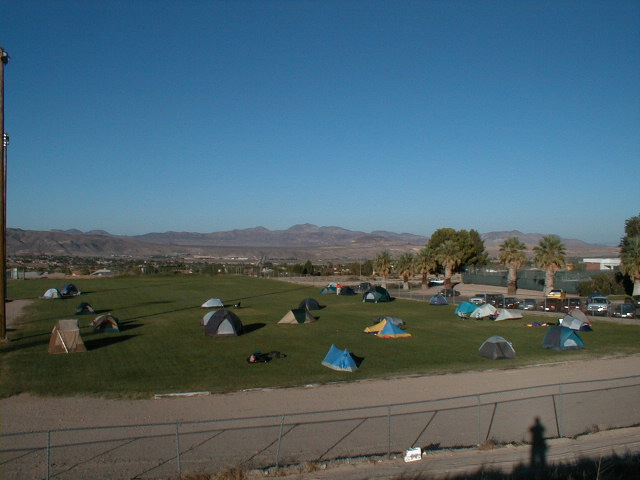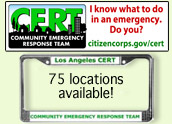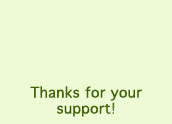2000 SAR City
by Rick Wood
SAR City is a gathering of people who are involved in the Search and Rescue world. It gathers several hundred people together on the second full weekend of October every year from all over the western United States, and a few from Canada. The focus is saving lives effectively and efficiently without endangering the rescuers. All things considered, that is a pretty wide open scope of interest, and one that I cannot cover adequately here. All I can tell you is what I did this year, and perhaps touch on what I've done in years past, to give you an idea of what a Search and Rescue seminar weekend is like.
 There are the traditional courses taught. In this picture, you can see teaching and practical exercise in low angle rescue. This hill is about 25 to 30 degrees, which is
not really that steep, one would think. Certainly on TV and the movies this small angle of rise is overcome by people simply walking the Stokes Litter up the hill to the waiting ambulance, right?
In real life, using rope assist like this in low-angle situations is a much better means of getting the injured person out of the situation without causing further injury, and without any rescuers
getting hurt. This anchoring exercise was set up and torn down in a matter of minutes, so the time lost in setting up the anchoring and rope assist is minimal compared to the increase in victim and
rescuer safety. That follows one of the basic precepts of Search and Rescue, which is, "Do not bring, nor create, more victims at the scene of a disaster in the form of would-be rescuers." Safety
is first, last and foremost for everyone, rescuer as well as the victim we are rescuing.
There are the traditional courses taught. In this picture, you can see teaching and practical exercise in low angle rescue. This hill is about 25 to 30 degrees, which is
not really that steep, one would think. Certainly on TV and the movies this small angle of rise is overcome by people simply walking the Stokes Litter up the hill to the waiting ambulance, right?
In real life, using rope assist like this in low-angle situations is a much better means of getting the injured person out of the situation without causing further injury, and without any rescuers
getting hurt. This anchoring exercise was set up and torn down in a matter of minutes, so the time lost in setting up the anchoring and rope assist is minimal compared to the increase in victim and
rescuer safety. That follows one of the basic precepts of Search and Rescue, which is, "Do not bring, nor create, more victims at the scene of a disaster in the form of would-be rescuers." Safety
is first, last and foremost for everyone, rescuer as well as the victim we are rescuing.
Every year some of us choose to become automobile re-designers. We start with two cars from the wrecking yard, which look for all the world like the kinds of vehicles we see every day on the streets. In a matter of two hours, both are reduced to roofless, doorless, hoodless, trunkless hulks. The Hurst Tool, more commonly known as the Jaws of Life, do an excellent job of removing anything and everything that can get in the way of a rescue. We are taught where to use the punch on the windshield, where the weak points on doors and posts are, and how to most safely and rapidly get a vehicle open.
This year, the San Bernardino County Sheriff's helicopter returned, primarily to help train search dogs and their handlers the finer points of being air-lifted into and out of a search area. Even the dogs have specialties these days. Some are trained to find living people who are trapped or lost. Others are trained to follow blood or injury scents. The newest specialty is the Cadaver Search Dog, who will pass up any number of living people following the scent to a dead body. Not all searches end in rescues. The sad part of S&R is that too often the "R" stands for "Recovery", not "Rescue".
 Many participants sleep on the campus. This is the Tent City that is set up on the softball diamonds. A large parking lot is devoted to those who travel in
RVs, trailers, vans, or just plain sleep in their cars. Some agencies have mobile command posts which are complete with shower, toilet, and sleeping facilities for an Incident Command Team, as well
as providing operational areas for laying out maps and communications areas for radio operators. Many vehicles like that are converted from private RVs by the people who own them, while others are
provided under the property forfeiture sections of some drug seizure laws. Most of the teams represented at SAR City are sponsored by law enforcement agencies, usually the Sheriff's Department,
which gives them an 'in' when it comes to using seized vehicles.
Many participants sleep on the campus. This is the Tent City that is set up on the softball diamonds. A large parking lot is devoted to those who travel in
RVs, trailers, vans, or just plain sleep in their cars. Some agencies have mobile command posts which are complete with shower, toilet, and sleeping facilities for an Incident Command Team, as well
as providing operational areas for laying out maps and communications areas for radio operators. Many vehicles like that are converted from private RVs by the people who own them, while others are
provided under the property forfeiture sections of some drug seizure laws. Most of the teams represented at SAR City are sponsored by law enforcement agencies, usually the Sheriff's Department,
which gives them an 'in' when it comes to using seized vehicles.
The curriculum is not entirely ropes and rescue and mapping and tracking. There are courses in administering a search, media relations, crimes against children, Alzheimer's Disease considerations, wilderness medicine for Doctors, Nurses, Medics and First Responders, winter survival, desert proofing, map and compass navigation, radio use, and use of horses. This year, a track was established to train people to become Amateur Radio operators. I took "Friction Firestarting" for fun, and learned to master a bowsaw and spindle kit to make fire with no matches. Last year I spent time learning Critical Stress Debriefing and dealing with death in SAR. Death is often too near in what we do; the weekend prior to SAR City, one of the invited guest speakers lost his life while on a rescue.
It was a good weekend. If you were there, I'm sorry I missed you. Please write a note or better yet, an article, which we could post here, if you are interested in doing that. If
you were not there, remember that the 29th Annual SAR City USA is coming up, October 12, 13 and 14, 2001.













